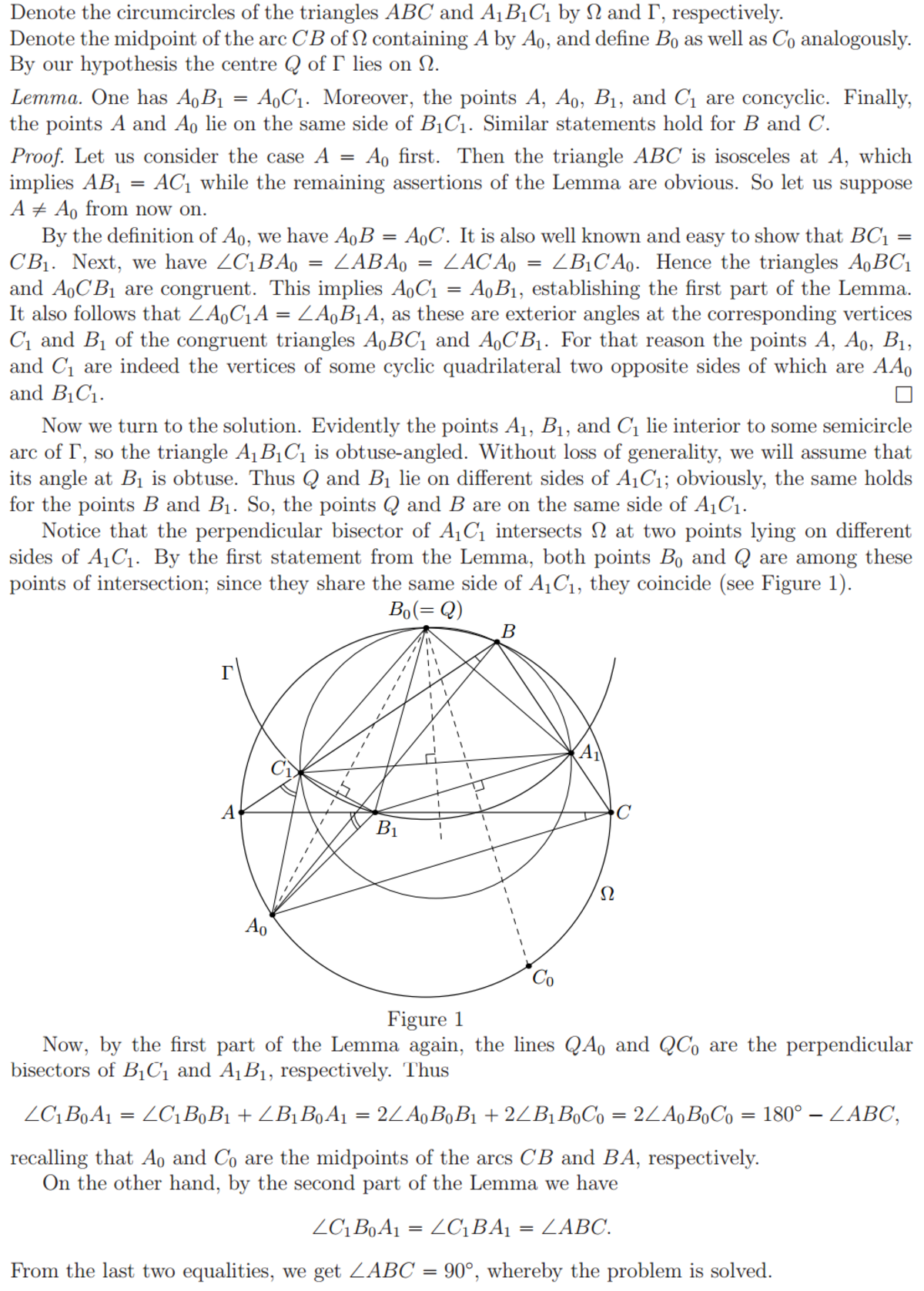Geometry Kings, Solve This!
Let the excircle of the triangle lying opposite to touch its side at the point . Define the points and analogously. Suppose that the circumcentre of the triangle lies on the circumcircle of the triangle . Find the measure of the largest angle in triangle in degrees.
The answer is 90.
This section requires Javascript.
You are seeing this because something didn't load right. We suggest you, (a) try
refreshing the page, (b) enabling javascript if it is disabled on your browser and,
finally, (c)
loading the
non-javascript version of this page
. We're sorry about the hassle.

It is not logical that there would be three different angles for the Δ A B C . There must be some symmetry. So, the triangle must be an isosceles. Let BC be the base. ∴ A 1 A ⊥ B C . The line of symmetry is thus A A 1 . Plotting the triangle ABC in X-Y, plane, C(0,0), and BC along X-asis, A above BC with ∠ A = 2 α . L e t O , O 1 b e t h e c i r c u m c e n t e r s o f Δ s A B C , A 1 B 1 , C 1 . O B t h e e x − c e n t e r , e x − c i r c l e t o u c h i n g A C a t B 1 . C O B , a n d A O B are external angle bisectors. ∴ all angles as shown on the sketch. O_1 must be above BC on the side of A. B e c a u s e o f s y m m e t r y , A 1 , A , O 1 , O m u s t b e o n A A 1 , t h e l i n e o f s y m m e t r y . S o , O 1 m u s t b e a t A . W i t h o u t l o s s o f g e n e r a l i t y l e t A C = 1 . B U T i n Δ O B A C , b a s e a n g l e s a r e e q u a l , ∴ A O B = A C = 1 . A i s ( − S i n α , C o s α ) . ∵ ∠ O B A C = ∠ A C B , A O B ∣ ∣ B C . O B X = A O B − S i n α = 1 − S i n α , O B Y = A Y = C o s α . R e m e m b e r , A ≡ O 1 . C i r c u m r a d i u s o f A 1 B 1 C 1 , R 1 = O 1 A 1 = O 1 B 1 . O 1 A 1 = 1 ∗ C o s α . ∴ O 1 B 1 = C o s α . ∴ O 1 C B 1 C = 1 1 − C o s α . ⟹ B 1 i s ( ( 1 − C o s α ) ∗ ( − S i n α ) , ( 1 − C o s α ) ∗ C o s α ) . ∴ S l o p B 1 O B = O B X − B 1 X O B Y − B 1 Y = 1 − S i n α − ( 1 − C o s α ) ∗ ( − S i n α . ) C o s α − ( 1 − C o s α ) ∗ C o s α ∴ s l o p B 1 O B = 1 − C o s α ∗ S i n α C o s 2 α . B 1 O B ⊥ A C . S l o p A C = − C o t α . ∴ s l o p B 1 O B = T a n α . S o l v i n g = 1 − C o s α ∗ S i n α C o s 2 α − T a n / a l p h a = 0 , i n g r a p h i n g c a l c u l a t o r , α = 4 5 o . ⟹ g r e a t e s t a n g l e A = 2 ∗ 4 5 = 9 0 o .